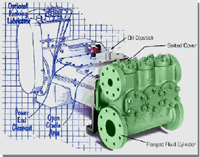New, Used, and Refurbished Wheatley & GASO Pumps, and Pump Parts.
Your best source for Wheatley & Gaso Pumps, Parts, Information, and Services.
Pumps Parts
In addition to a Library of information on operating and designing pump systems, we offer a database of Pumps & Parts.
Get a QuoteService
Contact Us| Pump | Specifications | |||||
| Pump Type | Model | Pump Style | Pump Title | Stroke | U.S. Gallons per Minute (GPM) | Max Brake Horse Power (BHP) |
| Simplex Plunger | Wheatley |
|
|
|
||
| Duplex Plunger | Wheatley |
|
|
|
||
| Duplex Piston | Wheatley |
|
|
|
||
| Gaso |
|
|
|
|||
| Gaso |
|
|
|
|||
| Gaso |
|
|
|
|||
| Gaso |
|
|
|
|||
| Gaso |
|
|
|
|||
| Gaso |
|
|
|
|||
| Triplex Plunger | Wheatley |
|
|
|
||
| Wheatley |
|
|
|
|||
| Gaso |
|
|
|
|||
| Gaso |
|
|
|
|
||
| Wheatley |
|
|
|
|||
| Wheatley |
|
|
|
|||
| Wheatley |
|
|
|
|||
| Gaso |
|
|
|
|||
| Gaso |
|
|
|
|||
| Gaso |
|
|
|
|||
| Gaso |
|
|
|
|||
| Gaso |
|
|
|
|||
| Wheatley |
|
|
|
|||
| Gaso |
|
|
|
|||
| Gaso |
|
|
|
|||
| Gaso |
|
|
|
|||
| Gaso |
|
|
|
|||
| Gaso |
|
|
|
|||
| Wheatley |
|
|
|
|||
| Gaso |
|
|
|
|||
| Quintuplex Plunger | Wheatley |
|
|
|
||
| Wheatley |
|
|
|
|||
| Wheatley |
|
|
|
|||
| Wheatley |
|
|
|
|||
| Wheatley |
|
|
|
|||
| Gaso |
|
|
|
|||
| Gaso |
|
|
|
|||
| Wheatley |
|
|
|
|||
| Gaso |
|
|
|
|||
| Gaso |
|
|
|
|||
| Wheatley |
|
|
|
|||
| Wheatley |
|
|
|
|||
| Pump | Specifications | |||||
| Pump Type | Model | Pump Style | Pump Title | Stroke | U.S. Gallons per Minute (GPM) | Max Brake Horse Power (BHP) |
| Simplex Plunger | GASO |
|
|
|
||
| Duplex Piston | WHEATLEY |
|
|
|
||
| WHEATLEY |
|
|
|
|||
| WHEATLEY |
|
|
|
|||
| WHEATLEY |
|
|
|
|||
| GASO |
|
|
|
|||
| GASO |
|
|
|
|||
| WHEATLEY |
|
|
|
|||
| WHEATLEY |
|
|
|
|||
| WHEATLEY |
|
|
|
|||
| GASO |
|
|
|
|||
| GASO |
|
|
|
|||
| GASO |
|
|
|
|||
| GASO |
|
|
|
|||
| WHEATLEY |
|
|
|
|||
| WHEATLEY |
|
|
|
|||
| WHEATLEY |
|
|
|
|||
| WHEATLEY |
|
|
|
|||
| WHEATLEY |
|
|
|
|||
| WHEATLEY |
|
|
|
|||
| WHEATLEY |
|
|
|
|||
| GASO |
|
|
|
|||
| GASO |
|
|
|
|||
| WHEATLEY |
|
|
|
|||
| WHEATLEY |
|
|
|
|||
| WHEATLEY |
|
|
|
|||
| WHEATLEY |
|
|
|
|||
| WHEATLEY |
|
|
|
|||
| WHEATLEY |
|
|
|
|||
| Triplex Plunger | WHEATLEY |
|
|
|
||
| WHEATLEY |
|
|
|
|||
| GASO |
|
|
|
|||
| GASO |
|
|
|
|||
| GASO |
|
|
|
|||
| GASO |
|
|
|
|||
| GASO |
|
|
|
|||
| GASO |
|
|
|
|||
| GASO |
|
|
|
|||
| GASO |
|
|
|
|||
| GASO |
|
|
|
|||
| GASO |
|
|
|
|||
| GASO |
|
|
|
|||
| WHEATLEY |
|
|
|
|||
| W-G |
|
|
|
|||
| WHEATLEY |
|
|
|
|||
| WHEATLEY |
|
|
|
|||
| WHEATLEY |
|
|
|
|||
| NATIONAL |
|
|
|
|||
| NATIONAL |
|
|
|
|||
| WHEATLEY |
|
|
|
|||
| WHEATLEY |
|
|
|
|||
| WHEATLEY |
|
|
|
|||
| WHEATLEY |
|
|
|
|||
| WHEATLEY |
|
|
|
|||
| WHEATLEY |
|
|
|
|||
| WHEATLEY |
|
|
|
|||
| WHEATLEY |
|
|
|
|||
| WHEATLEY |
|
|
|
|||
| WHEATLEY |
|
|
|
|||
| WHEATLEY |
|
|
|
|||
| GASO |
|
|
|
|||
| GASO |
|
|
|
|||
| WHEATLEY |
|
|
|
|||
| WHEATLEY |
|
|
|
|||
| Triplex Piston | GASO |
|
|
|
||
| GASO |
|
|
|
|||
| WHEATLEY |
|
|
|
|||
| Quintuplex Plunger | GASO |
|
|
|
||
| GASO |
|
|
|
|||
| GASO |
|
|
|
|||
| GASO |
|
|
|
|||
| WHEATLEY |
|
|
|
|||
| WHEATLEY |
|
|
|
|||
| WHEATLEY |
|
|
|
|||
| WHEATLEY |
|
|
|
|||
| WHEATLEY |
|
|
|
|||
| WHEATLEY |
|
|
|
|||
| Quintuplex Piston | WHEATLEY |
|
|
|
||
| GASO |
|
|
|
|||
